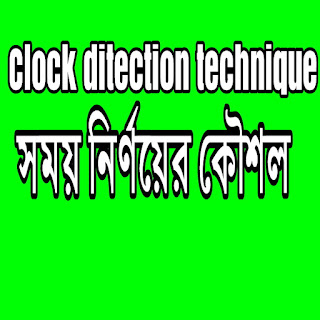Clock detection technique
: Think about the clock before solving the question. The whole clock is like a circle. Then a circle is equal to 4 equal angle, ie 4 right angle or 360 ° Now imagine that the total number is 12. Then there will be an angle for every hour (360 ° ÷ 12) = 30 °. When extracting the value of the angle, remember that no one will be more than 180 ° or the difference is greater than 6. Now let's have some questions. Question 1: How many degrees in the clock when the angle between four o'clock, the hour's thorn and the minute thorns? Answer: 120 ° . Explanation: When it is four o'clock, the thorns will be at 4am and the thorns will be at 12 in the middle. As a result, the difference between the two cuts will be 4. I have already found out that the angle value for every hour is 30 °, so the angle value for 4 would be (30 ° x 4) = 120 ° . Question 2: How many degrees when the clock is at eight o'clock in the clock, the thorn and the thorn in the minute? Answer: 120 ° . Explanation: When the clock turns eight o'clock, the thorns will be at 8 o'clock and the thorns will be at 12 o'clock. As a result, the difference between the two cuts will be 4. Somebody can say 12 to 8 times the distance between 8 and 8, but it can not be done because the angle will be greater than 180 °, before the angle value can not be more than 180 °, so the difference will never be greater than 6. So the gap between 8 to 12 will be 4. I have already found out that the angle value for every hour is 30 °, so the angle value for 4 would be (30 ° x 4) = 120 ° . Question 3: When the clock is about eleven o'clock in the clock, how many degrees of angle between the thorns and minute thorns? Answer: 165 ° . Explanation: When the needle is eleven o'clock, the thorns will be between 11 and 12 midway, 11.5 and the minus one at 6. As a result, the difference between the two cuts will be 5.5. Others may think that the distance can be 6.5 and. Yes may be, but in this case there will never be more than 6, so from which the interval between the six is equal to 6. I have already found that the angle value for 30 hours is equal to angle for every hour (30 ° × 5.5) = 165 °. If you remember just 1, then within 15 - 20 seconds, you can answer the following digits of the distance between the clock, hour and minute of the cut. Technique: (11 × M - 6O × H) ÷ 2 here, M = minute H = hour For example, if the clock is 2 to 40 minutes, then the degree of cutting and minimizing the number of minutes produces no. Formula: (11 × M - 6O × H) ÷2, (Here the minutes and places of H in place of M is to be set) Solution: (11x4O-6O × 2) ÷2 = 160 (U) [Bidra: It exceeds ° (that is, more than 180 °), but if the value obtained is reduced by 360, then its value must be calculated]
Send












Khanki
ReplyDeletegd
DeleteNic
Deletebest said...
DeleteSo sweet
DeleteHi
DeleteEow
ReplyDeletenice
ReplyDeleteWow
ReplyDeletenice
ReplyDeleteNice
ReplyDeleteFine
DeleteSei
ReplyDeletebetter
ReplyDeletebetter
ReplyDeleteNice
ReplyDeleteNice
ReplyDeleteGd
ReplyDeletenice this
ReplyDeleteLike this
ReplyDeleteNC
ReplyDeletewow
ReplyDeletewow
ReplyDeleteWow
ReplyDeleteSuper
ReplyDeletewow
ReplyDeleteJdbsmdnd
ReplyDeleteosam
ReplyDeletewow
ReplyDeleteNice
ReplyDeleteNice
ReplyDeleteSjsjddb
ReplyDeleteNice
ReplyDeleteNice
ReplyDeleteWonderful
ReplyDeleteNice
ReplyDeleteNice
ReplyDeleteNice
ReplyDeleteNice
ReplyDeleteNice
ReplyDeleteNice
ReplyDeleteAwesome
ReplyDeleteGood
ReplyDeleteWow
ReplyDeletexoxxs
ReplyDeleteJoss
ReplyDeleteThanks
ReplyDeleteNice
ReplyDeleteFine
ReplyDeletewow
ReplyDeletewow
ReplyDeleteTi
ReplyDeleteGood post
ReplyDeleteNice
ReplyDeleteGood
ReplyDeletegreat post
ReplyDeletejoss
ReplyDeleteHmmm good
ReplyDeleteFan
ReplyDeleteNice
ReplyDeleteR wosam
ReplyDeleteHmmm well
ReplyDeletePo good
ReplyDeleteJoos
ReplyDeletewill
ReplyDeletegood
ReplyDeleteGood
ReplyDeleteVlo
ReplyDeleteosam
ReplyDeletewow
ReplyDeleteHmmm nice
ReplyDeleteNice
ReplyDeleteHmmm vlo
ReplyDeletehelpful
ReplyDeleteVery good
ReplyDeletegood
ReplyDeleteVery nice
ReplyDeleteNyc
ReplyDeletenice
ReplyDeletesweet
ReplyDeletenice
ReplyDeleteNice
ReplyDeletegreat
ReplyDeleteWow
Deletenice
ReplyDeleteNice
ReplyDeleteC
ReplyDeleteE
ReplyDeleteNicely
ReplyDeleteNice...
ReplyDeleteG
ReplyDeleteNice
ReplyDeleteexcellent
ReplyDeleteGot information
ReplyDeleteJ
ReplyDeleteSwt
ReplyDeleteHmmm sweet
ReplyDeleteHmmm swt
ReplyDeleteWow
ReplyDeleteGd
ReplyDeleteFantastic
ReplyDeletenice
ReplyDeleteSera
ReplyDeleteNice
ReplyDeletewow
ReplyDeleteSt
ReplyDeletefine
ReplyDeletewow
ReplyDeletenice
ReplyDeleteMagnificent
ReplyDeleteN
ReplyDeletenice
ReplyDeleteG
ReplyDeleteNice
ReplyDeleteN
ReplyDeletenice
ReplyDeletewow
ReplyDeleteNice
ReplyDeleteA
ReplyDeleteExcelent
ReplyDeleteNice
ReplyDeleteExcellent
ReplyDeleteNice project
ReplyDeleteW
ReplyDeleteproud
ReplyDeleteSuper hoise
ReplyDeletejosd
ReplyDeletewell
ReplyDeleteNic
ReplyDeletexoxxs
ReplyDeleteWow
ReplyDeleteWell
ReplyDeleteWow
ReplyDeleteButiful
ReplyDeletejoss
ReplyDeleteHmmm wow
ReplyDeleteNice
ReplyDeleteHmm good
ReplyDeleteGood job
ReplyDeleteNice
ReplyDeleteSo nic
ReplyDeleteNice go
ReplyDeletewell
ReplyDeletesweet
ReplyDeleteJoss
ReplyDeleteAwesome
ReplyDeletenice
ReplyDeletewell
ReplyDeletegood
ReplyDeleteWwooww
ReplyDeleteHmm
ReplyDeletewell
ReplyDeleteOsam
ReplyDeleteGood
ReplyDeletejoss
ReplyDeleteasom
ReplyDeleteHmmm asm
ReplyDeleteSo sweet
ReplyDeleteSupper
ReplyDelete😯😯😯
ReplyDeleteEasy
ReplyDeleteKi
ReplyDeleteNice
ReplyDeleteNice
ReplyDelete😎😎😎
ReplyDeleteনেক্সট
ReplyDeleteYoyo
ReplyDeleteGood
ReplyDeleteNice
ReplyDeleteGood luck to you
ReplyDeleteJoss
ReplyDeleteNice
ReplyDelete